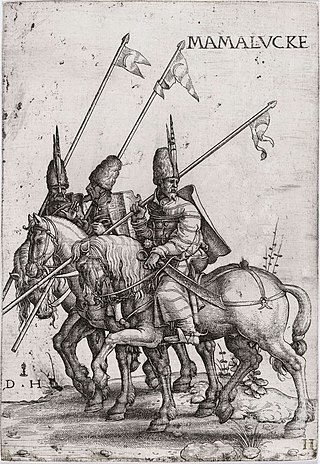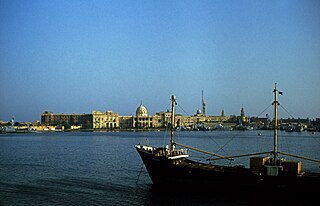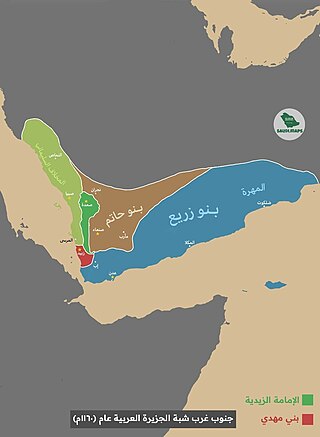
Mamluk or Mamaluk were non-Arab, ethnically diverse enslaved mercenaries, slave-soldiers, and freed slaves who were assigned high-ranking military and administrative duties, serving the ruling Arab and Ottoman dynasties in the Muslim world.

A dynasty is a sequence of rulers from the same family, usually in the context of a monarchical system, but sometimes also appearing in republics. A dynasty may also be referred to as a "house", "family" or "clan", among others.

Fuad I was the Sultan and later King of Egypt and the Sudan. The ninth ruler of Egypt and Sudan from the Muhammad Ali dynasty, he became Sultan in 1917, succeeding his elder brother Hussein Kamel. He replaced the title of Sultan with King when the United Kingdom unilaterally declared Egyptian independence in 1922.
The history of Egypt under the Muhammad Ali dynasty (1805–1953) spanned the later period of Ottoman Egypt, the Khedivate of Egypt under British occupation, and the nominally independent Sultanate of Egypt and Kingdom of Egypt, ending with the Revolution of 1952 and the formation of the Republic of Egypt.

King of Egypt was the title used by the ruler of Egypt between 1922 and 1951. When the United Kingdom issued the Unilateral Declaration of Egyptian Independence on 28 February 1922, thereby ending its protectorate over Egypt, Egypt's Sultan Fouad I issued a decree on 15 March 1922 whereby he adopted the title of King of Egypt. It has been reported that the title change was due not only to Egypt's newly independent status, but also to Fouad I's desire to be accorded the same title as the newly installed rulers of the newly created kingdoms of Hejaz, Syria and Iraq. The second monarch to be styled King of Egypt was Fouad I's son Farouk I, whose title was changed to King of Egypt and the Sudan in October 1951 following the Wafdist government's unilateral abrogation of the Anglo-Egyptian Treaty of 1936. The monarchy was abolished on 18 June 1953 following the Egyptian Revolution of 1952 and the establishment of a republic. The third king, the infant Fuad II of Egypt, went into exile in Italy. The position was replaced by the President of Egypt on June 18 1953.

Mustafa Fazıl Pasha was an Ottoman-Egyptian prince of ethnic Albanian descent belonging to the Muhammad Ali Dynasty founded by his grandfather Muhammad Ali Pasha.

Sultan of Egypt was the status held by the rulers of Egypt after the establishment of the Ayyubid dynasty of Saladin in 1174 until the Ottoman conquest of Egypt in 1517. Though the extent of the Egyptian Sultanate ebbed and flowed, it generally included Sham and Hejaz, with the consequence that the Ayyubid and later Mamluk sultans were also regarded as the Sultans of Syria. From 1914, the title was once again used by the heads of the Muhammad Ali dynasty of Egypt and Sudan, later being replaced by the title of King of Egypt and Sudan in 1922.

Al-Rifa'i Mosque is located in Citadel Square, adjacent to the Cairo Citadel. Its name is derived from the Ali Abu Shubbak who is buried in the mosque. Now, it is also the royal mausoleum of Muhammad Ali's family. The building is located opposite the Mosque-Madrassa of Sultan Hassan, which dates from around 1361, and was architecturally conceived as a complement to the older structure as part of a vast campaign by the 19th century rulers of Egypt to both associate themselves with the perceived glory of earlier periods in Egypt's Islamic history and modernize the city.

The Emirate of Nejd or Imamate of Nejd was the Second Saudi State, existing between 1824 and 1891 in Nejd, the regions of Riyadh and Ha'il of what is now Saudi Arabia. Saudi rule was restored to central and eastern Arabia after the Emirate of Diriyah, the First Saudi State, having previously been brought down by the Ottoman Empire's Egypt Eyalet in the Ottoman–Wahhabi War (1811–1818).

Ras El Tin Palace is a palace on the coast of the Mediterranean Sea in Alexandria, Egypt. It is one of the official residences for a serving President of Egypt. Under the Muhammad Ali Dynasty of Egypt and Sudan, it was a royal palace. Ras El Tin Palace is the oldest royal Egyptian palace still in use.

The Muhammad Ali dynasty or the Alawiyya dynasty was the ruling dynasty of Egypt and Sudan from the 19th to the mid-20th century. It is named after its progenitor, Muhammad Ali of Egypt, regarded as the founder of modern Egypt.

The Imams of Yemen, later also titled the Kings of Yemen, were religiously consecrated leaders (imams) belonging to the Zaidiyyah branch of Shia Islam. They established a blend of religious and temporal-political rule in parts of Yemen from 897. Their imamate endured under varying circumstances until the end of the North Yemen Civil War in 1970, following the republican revolution in 1962. Zaidiyyah theology differs from Isma'ilism and Twelver Shi’ism by stressing the presence of an active and visible imam as leader. The imam was expected to be knowledgeable in religious scholarship, and to prove himself a worthy headman of the community, even in battle if this was necessary. A claimant of the imamate would proclaim a "call" (dawah), and there were not infrequently more than one claimant.
The Sulayhid dynasty was an Ismaili Shi'ite Arab dynasty established in 1047 by Ali ibn Muhammad al-Sulayhi that ruled most of historical Yemen at its peak. The Sulayhids brought to Yemen peace and a prosperity unknown since Himyaritic times. The regime was confederate with the Cairo-based Fatimid Caliphate, and was a constant enemy of the Rassids - the Zaidi Shi'ite rulers of Yemen throughout its existence. The dynasty ended with Arwa al-Sulayhi affiliating to the Taiyabi Ismaili sect, as opposed to the Hafizi Ismaili sect that the other Ismaili dynasties such as the Zurayids and the Hamdanids adhered to.

Prince Abbas Hilmi is an Egyptian and Ottoman prince and financial manager. A member of the Muhammad Ali Dynasty, he is the only son of Prince Muhammad Abdel Moneim and his Ottoman wife Princess Neslişah, and grandson of Khedive Abbas Hilmi II Bey.

Muhammad Ali was the Ottoman Albanian governor and de facto ruler of Egypt from 1805 to 1848, considered the founder of modern Egypt. At the height of his rule, he controlled Egypt, Sudan, Hejaz, Najd, the Levant, Crete and parts of Greece.

The Zurayids, were a Yamite Hamdani dynasty based in Yemen in the time between 1083 and 1174. The centre of its power was Aden. The Zurayids suffered the same fate as the Hamdanid sultans, the Sulaymanids and the Mahdids, since their lands were taken over by the Ayyubids, and they themselves were liquidated. They were a Shia Ismaili dynasty that followed the Fatimid Caliphs based in Egypt. They were also Hafizi Ismaili as opposed to the Taiyabi Ismaili.
The Albanian community in Egypt began with government officials and military personnel appointed in Ottoman Egypt. A substantial community would grow up later by soldiers and mercenaries who settled in the second half of the 18th century and made a name for themselves in the Ottoman struggle to expel French troops in 1798–1801. Mehmet Ali or Muhammad Ali, an Albanian, would later found the Khedivate of Egypt which lasted there until 1952. In the 19th and early 20th centuries, many other Albanians settled into Egypt for economical and political reasons. However, in later years the activities of the fedayeen, Muslim Brotherhood, as well as the greater Egyptian Revolution of 1952 resulted in the Albanian community in Egypt largely abandoning the country and emigrating to Western countries. It is got estimated that recently were 18,000 Albanians in Egypt, but in the past were most numerous that today.

Hosh al-Basha, also Hosh el-Basha, Hawsh al-Basha, or Hosh el-Pasha), is a mausoleum of the royal family of Muhammad Ali Pasha at road al-Imam Al-Shafi‘i in the Southern Cemetery of Cairo, Egypt.














